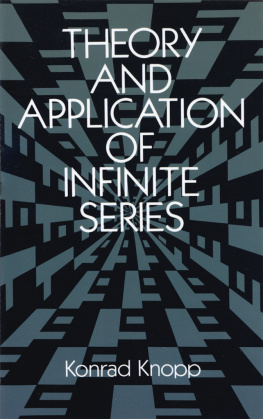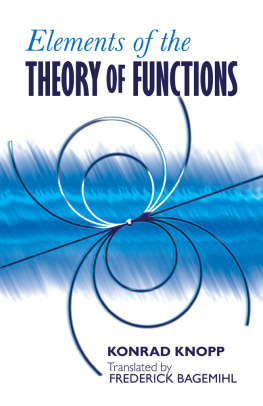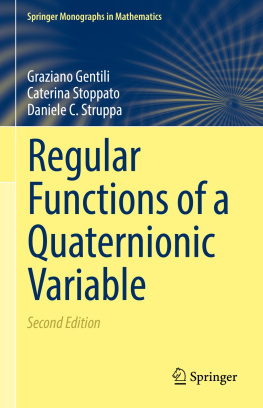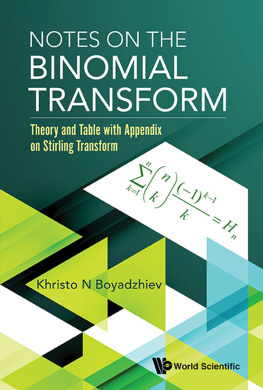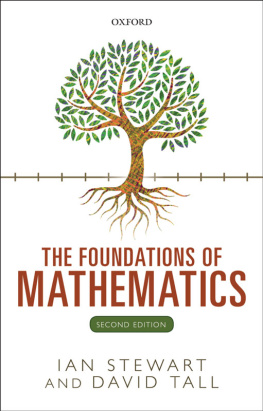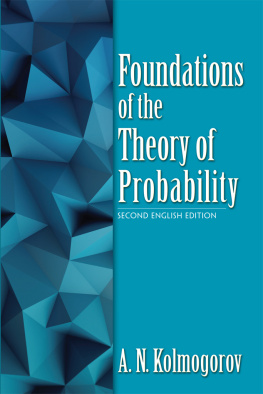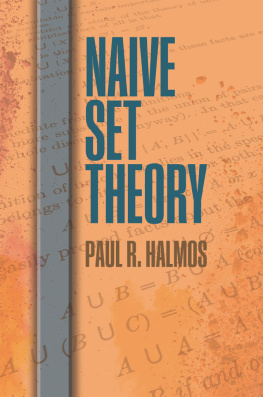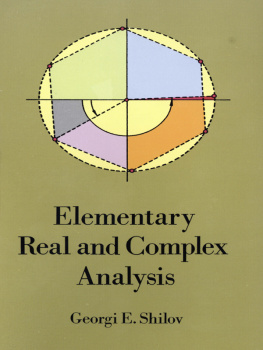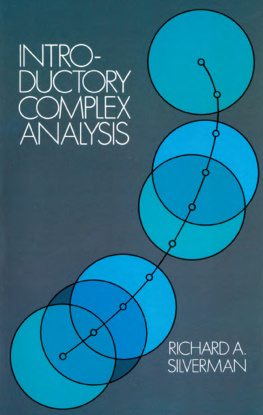THEORY AND APPLICATION OF INFINITE SERIES
BY
D R . K ONRAD K NOPP
LATE PROFESSOR OF MATHEMATICS AT THE
UNIVERSITY OF TBINCEN
Translated
from the Second German Edition
and revised
in accordance with the Fourth by
Miss R. C. H. Young, Ph.D., L.sSc.
DOVER PUBLICATIONS, INC.
New York
This Dover edition, first published in 1990 is an unabridged and unaltered republication of the second English edition published by Blackie & Son, Ltd., in 1951. It corresponds to the fourth German edition of 1947. The work was first published in German in 1921 and in English in 1928. This edition is published by special arrangement with Blackie & Son, Ltd., Bishopbriggs, Glasgow G64 2NZ, Scotland.
Manufactured in the United States of America
Dover Publications, Inc., 31 East 2nd Street, Mineola, N.Y. 11501
Library of Congress Cataloging-in-Publication Data
Knopp, Konrad, 1882-1957.
[Theorie und Anwendung der unendlichen Reihen. English]
Theory and application of infinite scries / by Konrad Knopp; translated from the second German edition and revised in accordance with the fourth by R.G.H. Young.
p. cm.
Translation of: Theorie und Anwendung der unendlichen Reihen.
Reprint. Originally published: London : Blackie, [1951].
Includes bibliographical references.
ISBN 0-486-66165-2
1. Series, Infinite. I. Title.
QA295.K74 1990
515.243dc20
89-71388
CIP
From the preface to the first (German) edition.
There is no general agreement as to where an account of the theory of infinite series should begin, what its main outlines should be, or what it should include. On the one hand, the whole of higher analysis may be regarded as a field for the application of this theory, for all limiting processes including differentiation and integration are based on the investigation of infinite sequences or of infinite series. On the other hand, in the strictest (and therefore narrowest) sense, the only matters that are in place in a textbook on infinite series are their definition, the manipulation of the symbolism connected with them, and the theory of convergence.
In his Vorlesungen ber Zahlen- und Funktionenlehre, Vol. 1, Part 2, A. Pringsheim has treated the subject with these limitations. There was no question of offering anything similar in the present book.
My aim was quite different: namely, to give a comprehensive account of all the investigations of higher analysis in which infinite series are the chief object of interest, the treatment to be as free from assumptions as possible and to start at the very beginning and lead on to the extensive frontiers of present-day research. To set all this forth in as interesting and intelligible a way as possible, but of course without in the least abandoning exactness, with the object of providing the student with a convenient introduction to the subject and of giving him an idea of its rich and fascinating variety such was my vision.
The material grew in my hands, however, and resisted my efforts to put it into shape. In order to make a convenient and useful book, the field had to be restricted. But I was guided throughout by the experience I have gained in teaching I have covered the whole of the ground several times in the general course of my work and in lectures at the universities of Berlin and Knigsberg and also by the aim of the book. It was to give a thorough and reliable treatment which would be of assistance to the student attending lectures and which would at the same time be adapted for private study.
The latter aim was particularly dear to me, and this accounts for the form in which I have presented the subject-matter. Since it is generally easier especially for beginners to prove a deduction in pure mathematics than to recognize the restrictions to which the train of reasoning is subject, I have always dwelt on theoretical difficulties, and have tried to remove them by means of repeated illustrations; and although I have thereby deprived myself of a good deal of space for important matter, I hope to win the gratitude of the student.
I considered that an introduction to the theory of real numbers was indispensable as a beginning, in order that the first facts relating to convergence might have a firm foundation. To this introduction I have added a fairly extensive account of the theory of sequences, and, finally, the actual theory of infinite series. The latter is then constructed in two storeys, so to speak: a ground-floor, in which the classical part of the theory (up to about the stage of Cauchys Analyse algbrique) is expounded, though with the help of very limited resources, and a superstructure, in which I have attempted to give an account of the later developments of the 19th century.
For the reasons mentioned above, I have had to omit many parts of the subject to which I would gladly have given a place for their own sake. Semi-convergent series, Eulers summation formula, a detailed treatment of the Gamma-function, problems arising from the hyper-geometric series, the theory of double series, the newer work on power series, and, in particular, a more thorough development of the last chapter, that on divergent series all these I was reluctantly obliged to set aside. On the other hand, I considered that it was essential to deal with sequences and series of complex terms. As the theory runs almost parallel with that for real variables, however, I have, from the beginning, formulated all the definitions and proved all the theorems concerned in such a way that they remain valid without alteration, whether the arbitrary numbers involved are real or complex. These definitions and theorems are further distinguished by the sign .
In choosing the examples in this respect, however, I lay no claim to originality; on the contrary, in collecting them I have made extensive use of the literature I have taken pains to put practical applications in the fore-front and to leave mere playing with theoretical niceties alone. Hence there are e. g. a particularly large number of exercises on Chapter VIII and only very few on Chapter IX. Unfortunately there was no room for solutions or even for hints for the solution of the examples.
A list of the most important papers, comprehensive accounts, and textbooks on infinite series is given at the end of the book, immediately in front of the index.
Knigsberg, September 1921.
From the preface to the second (German) edition.
The fact that a second edition was called for after such a remarkably short time could be taken to mean that the first had on the whole been on the right lines. Hence the general plan has not been altered, but it has been improved in the details of expression and demonstration on almost every page.
The last chapter, that dealing with divergent series, has been wholly rewritten, with important extensions, so that it now in some measure provides an introduction to the theory and gives an idea of modern work on the subject.
Knigsberg, December 1923.
Preface to the third (German) edition.
The main difference between the third and second editions is that it has become possible to add a new chapter on Eulers summation formula and asymptotic expansions, which I had reluctantly omitted from the first two editions. This important chapter had meanwhile appeared in a similar form in the English translation published by Blackie & Son Limited, London and Glasgow, in 1928.
In addition, the whole of the book has again been carefully revised, and the proofs have been improved or simplified in accordance with the progress of mathematical knowledge or teaching experience. This applies especially to theorems 269 and 287.
Dr. W. Schbe and Herr
Next page
